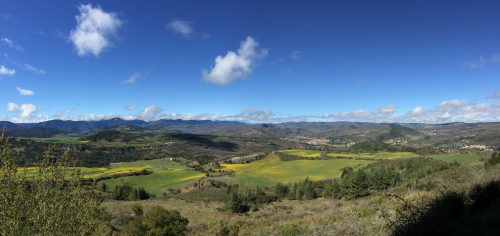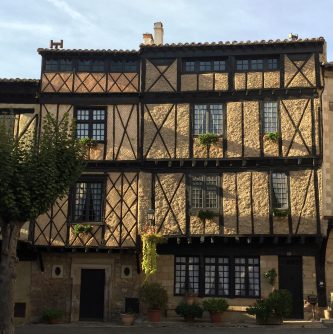The Southwest of France. The gorgeous Montagnes Noires in the Languedoc
France is a wonderland for tourist with surprise after surprise.
The Montagnes Noires in the Languedoc are no exception

One of the wonders of the world is surely the amount of world-class tourist sites that France hides away in the country. A short drive in almost any direction will lead to UNESCO protected caves, small galleries housing a world-class collection, truffle museums, discreet museums of ancient religious art in a small and little-visited abbeys.
The Languedoc is blessed with gorgeous scenery, delightful villages, festivals and events, a dramatic coast and a fabulous climate. One would be hard pressed to explore every nook and cranny from the Pyrenees to the Montagnes Noires, but we try very hard.

Guided by our friends Clement and Christel, and their delightful 12-year-old daughter Lucie, we headed off to the Minervois; this wonderful wine region lies to the north of Carcassonne, toward the ominously named Montagnes Noires. And as we drove toward them, they were distinctly noir.

Fortunately, unlike Spain, the rain ventures not to the plain, and stayed in the hills, but among a few drops, we arrived at the Gouffre Geant de Cabrespine. I hadn’t either, but no matter, it seems that the site has enough visitors.
It was extraordinary; standing in a massive cavern some one-hundred meters tall, and surrounded by the stalactites and stalagmites of both the most delicate and the most robust, it was impossible not to simply allow one’s jaw to drop and stare.
A simple, but effective lighting system, designed to both protect and illuminate, highlighted the various growths splendidly. We were told of a possible tour of four to five hours, that would include climbing down eighty metres of ladders to the ground and following into some of the seventeen kilometres of caves, caverns and rivers; tempting, but for next time.
Geology and time make superb partners; this cavern, the result of two massive limestone layers, one Devonian from 250 million years ago and one Silurian from 350 million years ago crashing together and forming the cave. It must have been a dramatic time to be alive.
The growth of the concretions formed only in the older Silurian stone, and together with the other extraordinary patterns, growths and frankly eerie shapes and shadows, made for the best science lesson that I can remember.
And what goes best with a couple of hours dabbling in speleology? Why truffles, of course, and so to the evocatively named Maison de la Truffe some ten kilometres up the road in the charming village of Villeneuve Minervois.
Truffles are mysterious, and although we were too late for the museum, the gift shop was open. As a consequence, we were introduced to an Aperitif Artisanal a la Truffe. Now I had never heard of any alcoholic drink being infused with the jus de truffe (1%), but I can assure you that it is a sound idea.
This along with truffle-infused oils (olive, grape seed and others), vinegars (balsamic and white varieties), mustards, pestos and a variety of other condiments. There were truffle knives, truffle graters, truffle inscribed egg-cups too although I couldn’t quite make that connection, and of course a variety of wild-boars (4,50 – 25,00, depending on size) and posters.
And, perhaps more importantly, we were told of the Truffle Festival that is taking place all day only 20kms from my house.
So, if you will excuse me, I shall go to the festival, and tell you all about it later.
